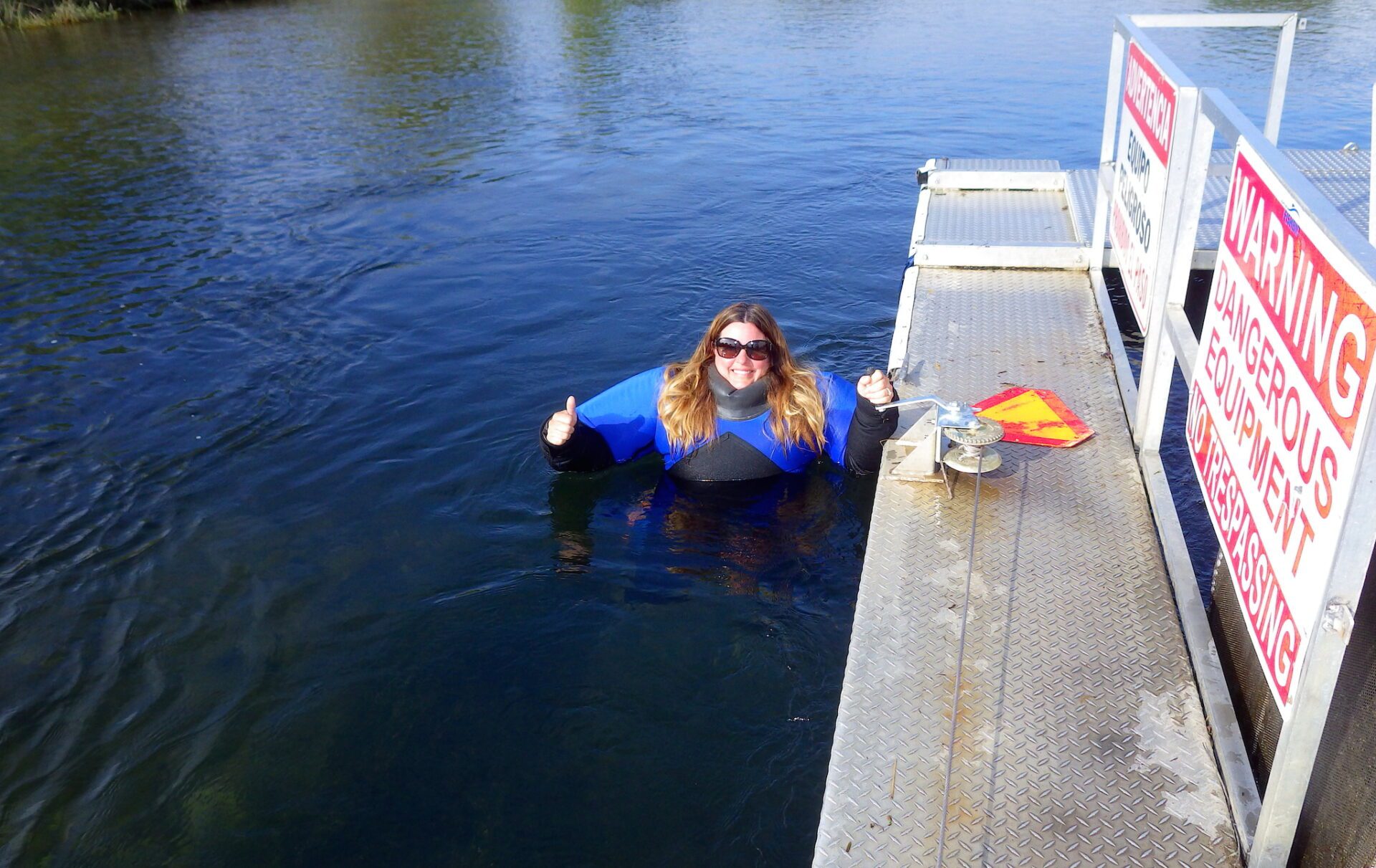Friday July 25, 2014
 While waders are the most common type of gear that anglers use to stay dry, our fisheries biologists usually don dry suits while sampling fish populations in the rivers. Unlike wetsuits, which keep you warm while still getting wet, a dry suit is made out of a type of waterproof material (usually neoprene or rubber) designed to prevent water from entering the suit at all, even when completely submerged. Dry suits come in a variety of styles to accommodate many different uses. Rubber seals at the neck and wrists (and sometimes feet, depending on the style) keep water out so that you stay completely dry inside. We prefer to use the more rugged and durable style made by USIA called a Stream Survey Suit. This suit is oversized and baggy to allow flexibility while working, has built in booties, and the outer layer is made of a more durable material that will withstand the environment in which we work.
While waders are the most common type of gear that anglers use to stay dry, our fisheries biologists usually don dry suits while sampling fish populations in the rivers. Unlike wetsuits, which keep you warm while still getting wet, a dry suit is made out of a type of waterproof material (usually neoprene or rubber) designed to prevent water from entering the suit at all, even when completely submerged. Dry suits come in a variety of styles to accommodate many different uses. Rubber seals at the neck and wrists (and sometimes feet, depending on the style) keep water out so that you stay completely dry inside. We prefer to use the more rugged and durable style made by USIA called a Stream Survey Suit. This suit is oversized and baggy to allow flexibility while working, has built in booties, and the outer layer is made of a more durable material that will withstand the environment in which we work.
 Similar to dry suits, waders are designed to keep the lower half of your body dry, but they will fill up with water if the water level goes beyond the top of the waders. We prefer to use waders when air temperatures are warm, water levels are low, and there is minimal contact with the water above the waist, such as during redd surveys, weir installations and monitoring, or rotary screw trap monitoring. We use dry suits most frequently while conducting snorkel surveys because our bodies are fully submerged and stream temperatures are often a chilly 50-60°F. We will also wear them during inclement weather conditions while working on the rotary screw traps or the portable resistant board weir. As a rule of thumb, if we know we would get wet (other than our hands and forearms) while wearing waders, we opt for a dry suit.
Similar to dry suits, waders are designed to keep the lower half of your body dry, but they will fill up with water if the water level goes beyond the top of the waders. We prefer to use waders when air temperatures are warm, water levels are low, and there is minimal contact with the water above the waist, such as during redd surveys, weir installations and monitoring, or rotary screw trap monitoring. We use dry suits most frequently while conducting snorkel surveys because our bodies are fully submerged and stream temperatures are often a chilly 50-60°F. We will also wear them during inclement weather conditions while working on the rotary screw traps or the portable resistant board weir. As a rule of thumb, if we know we would get wet (other than our hands and forearms) while wearing waders, we opt for a dry suit.
Although dry suits keep you dry, they do not provide much inherent insulation to keep you warm, so you must wear appropriate clothing underneath the suit for warmth. We recommend wearing any sort of wicking synthetic clothing (in the appropriate thickness for ambient temperatures), and to stay clear of cotton because of its tendency to trap moisture. Aside from keeping out water, dry suits offer great abrasion protection, which can be important in an untamed environment, as well as the ability to help keep you afloat. But be careful – too much floatation can turn you into the “Michelin Man,” like in the top picture. This is what happened when a biologist didn’t “burp the suit,” or let air out by pulling open the neck seal, as she walked into the water to a rotary screw trap. Once immersed, the excess air trapped in the suit rises towards the surface, causing the suit to “blow up.” This kind of unintended inflation makes for comical photos, but if you ever need more floatation, you can also pull open the neck seal of the suit and blow more air in!
